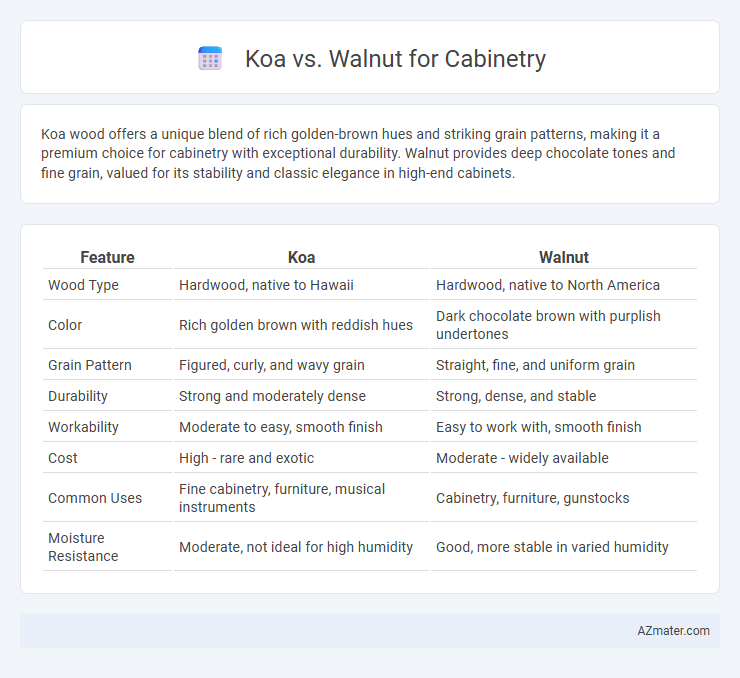Koa wood offers a unique blend of rich golden-brown hues and striking grain patterns, making it a premium choice for cabinetry with exceptional durability. Walnut provides deep chocolate tones and fine grain, valued for its stability and classic elegance in high-end cabinets.
Table of Comparison
| Feature | Koa | Walnut |
|---|---|---|
| Wood Type | Hardwood, native to Hawaii | Hardwood, native to North America |
| Color | Rich golden brown with reddish hues | Dark chocolate brown with purplish undertones |
| Grain Pattern | Figured, curly, and wavy grain | Straight, fine, and uniform grain |
| Durability | Strong and moderately dense | Strong, dense, and stable |
| Workability | Moderate to easy, smooth finish | Easy to work with, smooth finish |
| Cost | High - rare and exotic | Moderate - widely available |
| Common Uses | Fine cabinetry, furniture, musical instruments | Cabinetry, furniture, gunstocks |
| Moisture Resistance | Moderate, not ideal for high humidity | Good, more stable in varied humidity |
Introduction: Koa vs Walnut for Cabinetry
Koa and walnut are premium hardwoods widely used in cabinetry, each offering unique grain patterns and coloration that influence design aesthetics. Koa wood, native to Hawaii, is prized for its rich, curly grain and warm, reddish-brown tones, providing a distinctive tropical appeal. Walnut features a deep chocolate-brown color with straight to wavy grain, delivering a classic, elegant look favored in traditional and modern cabinetry.
Grain Patterns and Aesthetic Appeal
Koa wood features a rich, curly grain with a striking range of warm tones from golden brown to deep reddish hues, creating a vibrant, luxurious aesthetic for cabinetry. Walnut offers a smooth, straight grain with occasional waves and a deep, chocolate-brown color, exuding a classic, sophisticated appeal. The unique, intricate patterns of Koa make it ideal for standout pieces, while Walnut's uniform texture suits timeless, elegant designs.
Color Variations and Aging
Koa wood features rich, warm hues ranging from golden brown to deep reddish tones, developing a darker patina over time that enhances its natural beauty. Walnut offers a consistent dark chocolate brown color with subtle purple undertones, gradually mellowing to a rich, warm gray as it ages. Both woods maintain color depth, but Koa's vibrant variation and dynamic aging process appeal to those seeking a more striking, exotic cabinetry appearance.
Durability and Hardness Comparison
Koa wood offers moderate durability with a Janka hardness rating of approximately 1,200 psi, providing a balanced combination of strength and workability ideal for cabinetry. Walnut, with a Janka hardness around 1,010 psi, is slightly softer but still offers excellent resistance to wear and dents, ensuring long-lasting cabinetry surfaces. Both woods resist warping and are stable, though Koa's higher hardness contributes to greater scratch resistance over time compared to Walnut.
Workability and Machining Ease
Koa wood offers exceptional workability, with its fine texture and stability making it easy to cut and shape without splintering, ideal for detailed cabinetry. Walnut, renowned for its uniform grain and medium hardness, machines smoothly and accepts finishes well, enabling precise joinery and a polished look. Both woods machine easily, but Koa's natural oils may require sharper tools for clean cuts compared to the relatively drier walnut.
Cost and Availability Factors
Koa wood, sourced primarily from Hawaii, commands a higher price due to its rarity and limited availability outside its native region, making it a premium choice for cabinetry. Walnut, widely available across North America, offers a more affordable and consistent supply, appealing to budget-conscious projects without compromising on durability or aesthetic quality. The cost difference between Koa and Walnut directly reflects Koa's exotic status and scarcity compared to Walnut's broader accessibility in the cabinetry market.
Environmental Impact and Sustainability
Koa wood, native to Hawaii, is prized for its beauty but faces sustainability challenges due to limited old-growth availability and slow growth rates, resulting in stronger conservation regulations. Walnut, primarily sourced from North America and Europe, is more widely available and often harvested from managed forests, making it a more sustainable choice for cabinetry with lower environmental impact. Choosing walnut supports responsible forestry practices, while koa's environmental impact can be significant if not sourced from certified sustainable plantations.
Maintenance and Longevity
Koa wood offers excellent durability and ease of maintenance due to its natural oils that resist moisture and pests, making it ideal for long-lasting cabinetry. Walnut requires regular sealing and conditioning to prevent surface damage and maintain its rich, dark finish, as it is more prone to scratches and fading over time. Both woods offer longevity, but Koa's natural resilience often results in lower upkeep and extended cabinet life compared to Walnut.
Best Uses in Cabinetry Design
Koa wood offers a rich, warm grain ideal for high-end cabinetry where a luxurious and exotic appearance is desired, especially in custom furniture and accent pieces. Walnut provides a strong, durable option with a smoother and more uniform grain, making it suitable for both traditional and modern cabinetry requiring resilience and elegance. Both woods excel in different cabinetry contexts: Koa for standout decorative elements and Walnut for versatile, long-lasting cabinetry surfaces.
Conclusion: Choosing Between Koa and Walnut
Koa offers a striking, golden-brown hue with varied grain patterns that bring a warm, tropical aesthetic to cabinetry, while Walnut provides a rich, dark brown tone with consistent grain for a classic, elegant look. Durability differs slightly as Walnut tends to be harder and more resistant to dents, making it ideal for high-traffic areas, whereas Koa's stability and moisture resistance suit humid environments well. Selecting between Koa and Walnut hinges on desired visual impact and functional needs, balancing Koa's exotic appeal against Walnut's timeless strength.

Infographic: Koa vs Walnut for Cabinetry
 azmater.com
azmater.com